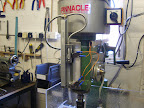If you'll take a look at the picture below (thumbnail link) you can see the limit switch wiring on my Z axis.
The X and Y are basically wired the same way, to the same "standard" and using the same wire.
There is a crap load of other stuff, including compressors and variable speed motor inverters, all sharing the same spur mains feed from the main house... of course the "workshop PC" shares this same power source.
The workshop PC itself is an ex corporate dell. It doesn't just run mach3, but is also burdened with some CAD software, CAM software, and is used to browse the net or simply play mp3s when I'm not doing CNC stuff.
The CNC electronics hardware itself is however half decent quality kit, originally Chinese made to be sure, but half decent nonetheless.
I'm posting this because it is worth making the point that despite what should be a pretty atrocious and problem ridden installation, I get basically zero problems, even when starting and stopping or varying the speed on the lathe motor, even when the compressors kick in, blah blah blah.
Clearly I'm running the same copy of Mach3 as everyone else, I don't have gold plated artsoft bytes, and bill gates didn't send me a personally made version of XP.
And yet is is as stable as can be.
Clearly stability is not something that can
only be achieved by the use of properly screened and grounded limit cables, etc etc etc.
So the variations between machines, why is mine stable and yours not? Logically must revolve around the stuff that is different.
The stuff that is different is going to be the actual workshop computer components / hardware / psu etc, and the stuff that is different is going to be the actual stepper circuits and even steppers themselves.
I used an old corporate PC and half decent stepper hardware, and the whole thing seems rock solid DESPITE my efforts to the contrary.
Whereas there doesn't appear to be any shortage of people having problems using high end laptops and heinz 57 flavours of stepper drivers and even USB interfaces between control computer and stepper electronics.
Clearly, logic dictates that installations like mine are proof that there is actually nothing whatsoever "wrong" with Mach3, or WindowsXP, or old corporate computers and parallel ports...
The alternative is that I am just ********* lucky and mach3 would run on an old casio watch provided it was within 5 metres of me, which isn't borne out by anything else around me.
HTH etc

From
CNC Mill Conversion
